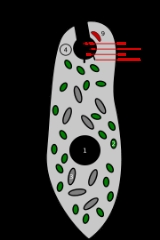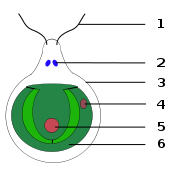
Eyespot apparatus
Encyclopedia


Organelle
In cell biology, an organelle is a specialized subunit within a cell that has a specific function, and is usually separately enclosed within its own lipid bilayer....
found in the flagellate (motile) cells of green algae
Green algae
The green algae are the large group of algae from which the embryophytes emerged. As such, they form a paraphyletic group, although the group including both green algae and embryophytes is monophyletic...
and other unicellular
Microorganism
A microorganism or microbe is a microscopic organism that comprises either a single cell , cell clusters, or no cell at all...
photosynthetic
Photosynthesis
Photosynthesis is a chemical process that converts carbon dioxide into organic compounds, especially sugars, using the energy from sunlight. Photosynthesis occurs in plants, algae, and many species of bacteria, but not in archaea. Photosynthetic organisms are called photoautotrophs, since they can...
organisms such as euglenid
Euglenid
Euglenoids are one of the best-known groups of flagellates, commonly found in freshwater especially when it is rich in organic materials, with a few marine and endosymbiotic members. Most euglenids are unicellular. Many euglenids have chloroplasts and produce energy through photosynthesis, but...
s. It allows the cells to sense light
Light
Light or visible light is electromagnetic radiation that is visible to the human eye, and is responsible for the sense of sight. Visible light has wavelength in a range from about 380 nanometres to about 740 nm, with a frequency range of about 405 THz to 790 THz...
direction and intensity and respond to it by swimming either towards the light (positive phototaxis
Phototaxis
Phototaxis is a kind of taxis, or locomotory movement, that occurs when a whole organism moves in response to the stimulus of light. This is advantageous for phototrophic organisms as they can orient themselves most efficiently to receive light for photosynthesis...
) or away from the light (negative phototaxis). A related response ("photoshock" or photophobic response) occurs when cells are briefly exposed to high light intensity, causing the cell to stop, briefly swim backwards, then change swimming direction. Eyespot-mediated light perception helps the cells in finding an environment with optimal light conditions for photosynthesis. Eyespots are the simplest and most common "eyes" found in nature, composed of photoreceptors
Photoreceptor protein
Photoreceptors are light-sensitive proteins involved in the sensing and response to light in a variety of organisms. Some examples are rhodopsin in the photoreceptor cells of the vertebrate retina, phytochrome in plants, and bacteriorhodopsin and bacteriophytochromes in some bacteria...
and areas of bright orange-red pigment granules. Signals relayed from the eyespot photoreceptors result in alteration the beating pattern of the flagella, generating a phototactic response.
Microscopic structure
Under the light microscope, eyespots appear as dark, orange-reddish spots or stigmata. They get their color from carotenoid pigments contained in bodies called pigment granules. The photoreceptors are found in the plasma membrane overlaying the pigmented bodies.The eyespot apparatus of Euglena
Euglena
Euglena is a genus of unicellular flagellate protists. It is the best known and most widely studied member of the phylum Euglenozoa , a diverse group containing some 44 genera and at least 800 species. Species of Euglena are found in fresh and salt waters...
comprises the paraflagellar body connecting the eyespot to the flagellum
Flagellum
A flagellum is a tail-like projection that protrudes from the cell body of certain prokaryotic and eukaryotic cells, and plays the dual role of locomotion and sense organ, being sensitive to chemicals and temperatures outside the cell. There are some notable differences between prokaryotic and...
. In electron microscopy
Electron microscope
An electron microscope is a type of microscope that uses a beam of electrons to illuminate the specimen and produce a magnified image. Electron microscopes have a greater resolving power than a light-powered optical microscope, because electrons have wavelengths about 100,000 times shorter than...
, the eyespot apparatus appears as a highly ordered lamellar structure formed by membranous rods in a helical arrangement.
In Chlamydomonas
Chlamydomonas
Chlamydomonas is a genus of green algae. They are unicellular flagellates. Chlamydomonas is used as a model organism for molecular biology, especially studies of flagellar motility and chloroplast dynamics, biogenesis, and genetics...
, the eyespot is part of the chloroplast
Chloroplast
Chloroplasts are organelles found in plant cells and other eukaryotic organisms that conduct photosynthesis. Chloroplasts capture light energy to conserve free energy in the form of ATP and reduce NADP to NADPH through a complex set of processes called photosynthesis.Chloroplasts are green...
and takes on the appearance of a membranous sandwich structure. It is assembled from chloroplast membrane
Chloroplast membrane
Chloroplasts contain several important membranes, vital for their function. Like mitochondria, chloroplasts have a double-membrane envelope, called the chloroplast envelope. Each membrane is a phospholipid bilayer, between 6 and 8 nm thick, and the two are separated by a gap of 10-20 nm,...
s (outer, inner, and thylakoid membranes) and carotenoid
Carotenoid
Carotenoids are tetraterpenoid organic pigments that are naturally occurring in the chloroplasts and chromoplasts of plants and some other photosynthetic organisms like algae, some bacteria, and some types of fungus. Carotenoids can be synthesized fats and other basic organic metabolic building...
-filled granules overlaid by plasma membrane. The stacks of granules act as a quarter-wave plate, reflecting incoming photons back to the overlying photoreceptors, while shielding the photoreceptors from light coming from other directions. It disassembles during cell division
Cell division
Cell division is the process by which a parent cell divides into two or more daughter cells . Cell division is usually a small segment of a larger cell cycle. This type of cell division in eukaryotes is known as mitosis, and leaves the daughter cell capable of dividing again. The corresponding sort...
and reforms in the daughter cells in an asymmetric fashion in relation to the cytoskeleton
Cytoskeleton
The cytoskeleton is a cellular "scaffolding" or "skeleton" contained within a cell's cytoplasm and is made out of protein. The cytoskeleton is present in all cells; it was once thought to be unique to eukaryotes, but recent research has identified the prokaryotic cytoskeleton...
. This asymmetric positioning of the eyespot in the cell is essential for proper phototaxis.
Eyespot proteins
The most critical eyespot proteins are the photoreceptor proteinPhotoreceptor protein
Photoreceptors are light-sensitive proteins involved in the sensing and response to light in a variety of organisms. Some examples are rhodopsin in the photoreceptor cells of the vertebrate retina, phytochrome in plants, and bacteriorhodopsin and bacteriophytochromes in some bacteria...
s that sense light. The photoreceptors found in unicellular organisms fall into two main groups: flavoprotein
Flavoprotein
Flavoproteins are proteins that contain a nucleic acid derivative of riboflavin: the flavin adenine dinucleotide or flavin mononucleotide ....
s and retinylidene protein
Retinylidene protein
Retinylidene proteins are a family of proteins that use retinal as chromophore for light reception. Proteins of this family are also called opsins...
s (rhodopsins). Flavoproteins are characterized by containing flavin molecules as chromophore
Chromophore
A chromophore is the part of a molecule responsible for its color. The color arises when a molecule absorbs certain wavelengths of visible light and transmits or reflects others. The chromophore is a region in the molecule where the energy difference between two different molecular orbitals falls...
s, whereas retinylidene proteins contain retinal
Retinal
Retinal, also called retinaldehyde or vitamin A aldehyde, is one of the many forms of vitamin A . Retinal is a polyene chromophore, and bound to proteins called opsins, is the chemical basis of animal vision...
. The photoreceptor protein in Euglena is likely a flavoprotein. In contrast, Chlamydomonas phototaxis is mediated by archaeal-type rhodopsins.
Besides photoreceptor proteins, eyespots contain a large number of structural, metabolic and signaling proteins. The eyespot proteome
Proteome
The proteome is the entire set of proteins expressed by a genome, cell, tissue or organism. More specifically, it is the set of expressed proteins in a given type of cells or an organism at a given time under defined conditions. The term is a portmanteau of proteins and genome.The term has been...
of Chlamydomonas cells consists of roughly 200 different proteins.
Photoreception and signal transduction
The Euglena photoreceptor was identified as a blue-light-activated adenylyl cyclase. Excitation of this receptor protein results in the formation of cyclic adenosine monophosphateCyclic adenosine monophosphate
Cyclic adenosine monophosphate is a second messenger important in many biological processes...
(cAMP) as a second messenger
Second messenger system
Second messengers are molecules that relay signals from receptors on the cell surface to target molecules inside the cell, in the cytoplasm or nucleus. They relay the signals of hormones like epinephrine , growth factors, and others, and cause some kind of change in the activity of the cell...
. Chemical signal transduction
Signal transduction
Signal transduction occurs when an extracellular signaling molecule activates a cell surface receptor. In turn, this receptor alters intracellular molecules creating a response...
ultimately triggers changes in flagellar beat patterns and cell movement.
The archaeal-type rhodopsins of Chlamydomonas contain an all-trans retinylidene chromatophore which undergoes photoisomerization to a 13-cis isomer. This activates a photoreceptor channel, leading to a change in membrane potential
Membrane potential
Membrane potential is the difference in electrical potential between the interior and exterior of a biological cell. All animal cells are surrounded by a plasma membrane composed of a lipid bilayer with a variety of types of proteins embedded in it...
and cellular calcium ion concentration. Photoelectric signal transduction ultimately triggers changes in flagellar strokes and thus cell movement.

